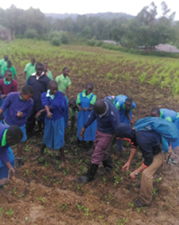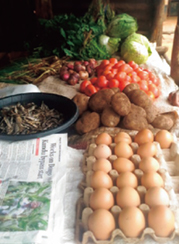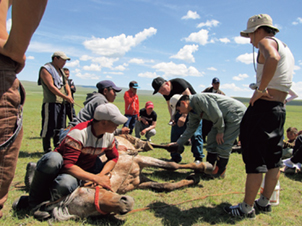(3) Promotion of Agriculture, Forestry and Fisheries, and Development of Food Value Chains
The population of undernourished people in the world still remains large, and the world's population growth is anticipated to further increase food demand. The SDGs sets Goal 1 as “End poverty in all its forms everywhere” and Goal 2 as “End hunger, achieve food security and improved nutrition, and promote sustainable agriculture,” etc. To achieve these goals and realize quality growth in developing countries, efforts to develop agriculture are an urgent challenge. In addition, three out of four of the poor in developing countries live in rural areas. Because the majority of these individuals rely on farming for a living, efforts to develop agriculture and rural communities are important.
<Japan's Efforts>
Based on the Development Cooperation Charter, Japan proactively addresses global food security issues, giving priority to cooperation that develops agriculture, forestry and fisheries, including the development of food value chains, in order to achieve “quality growth” in developing countries and to eradicate poverty through such growth. In the short term, Japan provides food assistance to developing countries to avert food shortages and in the medium- to long-term, Japan aims to help increase and improve agricultural production and productivity in developing countries in order to prevent and eliminate the causes of food-related problems including hunger.
Specifically, Japan uses its knowledge and experience to strengthen research and technology development, along with capacity-building to disseminate this technology in a way that is suited to the cultivation environment, to promote the sustainable use of fishery resources, to strengthen organizations of farmers, to assist in policymaking, as well as to improve infrastructure such as irrigation facilities, farm roads, and fishing ports.
Furthermore, with the aim of realizing food security and eradicating poverty in Africa, Japan contributes to the development of agriculture in Africa while placing strong emphasis on agriculture as an industry that plays an important role in Africa's economic growth. For instance, in Africa, Japan supports the research of NERICA* (New Rice for Africa) and the spread of its production techniques, and provides support for increasing rice production based on the Comprehensive Africa Agriculture Development Programme (CAADP), and for the introduction of the Smallholder Horticulture Empowerment Project (SHEP) approach,* among others. In addition, in order to assist in reducing post-harvest loss,* revitalizing the food industry, and increasing rural incomes, Japan also places priority on assistance for developing “food value chains.” This refers to creating a chain of added values focusing around food by enhancing the added value of agricultural, forestry and fishery products at each phase of the process from production and manufacturing to processing, distribution, and consumption, and linking these added values.
The Coalition for African Rice Development (CARD)* was established on the occasion of TICAD IV in 2008. CARD has set the goal of doubling rice production in Sub-Saharan Africa from 14 million tons as of 2008 to 28 million tons by 2018. The annual rice production in Sub-Saharan Africa had increased to 25.16 million tons by 2014, meaning that approximately 74% of the goal has been achieved.
Furthermore, in order to promote a shift from self-sufficient to profitable agriculture, Japan announced during TICAD V in 2013 that it would promote the SHEP approach to be applied widely in African countries, and develop 1,000 skilled agricultural trainers as well as organize smallholder's cooperatives consisting of 50,000 people through the SHEP approach.
On the occasion of TICAD VI held in 2016, Japan announced that in order to strengthen food security in Africa, it would transfer rice cultivation skills to 60,000 farmers and 2,500 extension workers by 2018 under the CARD initiative, and that it would promote market-oriented agriculture and developing the food value chain so as to enhance productivity and profitability of agriculture.
Since 2016, Japan has provided training for more than 13,000 people (more than 44,000 people since 2013) through the SHEP approach, towards the promotion of market-oriented agriculture. In addition, it has also transferred rice cultivation skills through CARD to more than 25,000 people since 2016.
The Ministry of Agriculture, Forestry and Fisheries (MAFF) is promoting the building of a food value chain for developing countries through public-private partnership, based on the Global Food Value Chain Strategy formulated in June 2014. In FY2016, based on this Strategy, it organized bilateral policy dialogues with Russia, Viet Nam, Thailand, Indonesia, Myanmar, Cambodia, and Uzbekistan. Among these countries, a work schedule has been formulated for public-private initiatives in Japan and Myanmar with the aim of building a food value chain in Myanmar.
With respect to food security through a multilateral cooperation approach, Japan proposed the concept of “Responsible Agricultural Investment (RAI)”* at the G8 L'Aquila Summit (Italy) held in 2009, which has since gained support at international fora such as the G7/8, G20, and APEC. In addition, based on the RAI concept, the “Principles for Responsible Investment in Agriculture and Food Systems,” having been discussed at the Committee on World Food Security (CFS) supported by a secretariat comprising the Food and Agriculture Organization of the United Nations (FAO), the International Fund for Agricultural Development (IFAD), and the World Food Programme (WFP), were adopted at the CFS 41st Session in 2014.
The New Alliance for Food Security and Nutrition, which was established at the G8 Camp David Summit (the United States) in 2012, releases a progress report every year, and now has ten partner countries. The Alliance has now become independent from the G7 process and operates autonomously under the New Alliance secretariat of the African Union Commission (AUC). In addition, under the framework of the New Alliance, the relevant international organizations are implementing the “Forward-looking research and analysis programme for responsible agricultural investment” with financial support from Japan.
At the G7 Schloss Elmau Summit (Germany) held in 2015, the Broader Food Security and Nutrition Development Approach was unveiled, which aimed to lift 500 million people in developing countries out of hunger and malnutrition by 2030.
At the G7 Taormina Summit (Italy) held in May 2017, the G7 Leaders reaffirmed their collective aim set out at the Schloss Elmau Summit. In particular, the G7 leaders recognized that urgent action was needed in Sub-Saharan Africa, and they decided to raise their collective support for food security, nutrition and sustainable agriculture.
Furthermore, Japan has provided assistance to the Agricultural Market Information System (AMIS)* in the G20, aiming to enhance the international agricultural market transparency. Further, Japan provides assistance in the agricultural sector through international organizations such as FAO, IFAD, the Consultative Group on International Agricultural Research (CGIAR), and WFP.
•Kenya
Introduction of the Smallholder Horticulture Empowerment and Promotion (SHEP) Approach
JICA volunteer program (2014 - )
Most of the farmers in Kenya are small-scale farmers who do not have sufficient income because they cannot sell their products at the price they expect to in the market.
In order to solve this problem, Japan has been implementing technical cooperation*1 in Kenya since 2006, aiming at reinforcing the organization of the farmers and increasing their incomes. As a result the mindset of the farmers producing fruits and vegetables has changed, from “Grow and Sell” to “Grow to Sell.” Moreover, the Smallholder Horticulture Empowerment and Promotion (SHEP) approach, which aims to enhance the incomes of farmers through improving their techniques of agribusiness and cultivation, has doubled the incomes of farmers on average. The SHEP approach is now being employed not only in Kenya but also in other countries of the African continent.

Children listening to the guidance from the agricultural office staff at an agricultural club (Photo: Seiichiro Koto / JICA)

Vegetables displayed for sale at a town in Kenya (Photo: Seiichiro Koto / JICA)

Children cultivating the soil before sowing seeds at an agricultural club (Photo: Seiichiro Koto / JICA)
Japan Overseas Cooperation Volunteers (JOCVs) have been introducing the SHEP approach and trying to have it take root in Kenya since 2014. The JOCV focuses on elementary schools. There are agricultural clubs called 4K clubs (the name is derived from the first letters of “Kuungana Kufanya Kusaidia Kenya,” which means in Swahili “work together to save Kenya”), which are operating traditionally in most of the Kenyan elementary schools.
Mr. Seiichiro Koto, a member of JOCV who has been dispatched to Kenya in 2016, is based at an agricultural office located in a small town and has been working to introduce the SHEP approach to the agricultural clubs in elementary schools. “I hope the agricultural population will increase in the future through the club activities, by learning the importance of planned agriculture and enjoying farming.” Mr. Koto explains.
As Mr. Koto has been admired and trusted by the local people, the number of 4K clubs which have decided to introduce the SHEP approach has doubled in one year, and Mr. Kato started to receive requests for his support from clubs targeting adults. Mr. Koto states his next challenge; “I would like to improve the program to make it more interesting so that children will join the activities on their own will.”(As of December 2017)
*1 Japan implemented the Smallholder Horticulture Empowerment and Promotion Project (SHEP) from 2006 to 2009, the Smallholder Horticulture Empowerment and Promotion Unit Project (SHEP UP) from 2010 to 2015, and is currently implementing the Smallholder Horticulture Empowerment and Promotion Project for Local and Up-Scaling (SHEP PLUS), which is scheduled to run from 2015 to 2020.
- *New Rice for Africa (NERICA)
- NERICA is a general term for rice developed in 1994 by the Africa Rice Center (formerly West Africa Rice Development Association [WARDA]) through the hybridization of high-yield Asian rice with African rice, which is resistant to weeds, diseases and insect pests. Japan has also contributed to the development of a variety of new types that are suited to the natural conditions of each region in Africa. The characteristics of the rice, include (i) a higher yield, (ii) a shorter growth period, (iii) higher resistance to dryness (drought), and (iv) higher resistance to diseases and insect pests than conventional rice. Since 1997, Japan has partnered with international organizations and NGOs to provide support for research and development related to new types of NERICA, test cultivation, and increased production and popularization of seeds. In addition, Japan has dispatched agricultural experts and JOCVs to offer cultivation training, and has also accepted trainees from Africa for training in Japan.
- *Smallholder Horticulture Empowerment Project (SHEP) approach
- The SHEP approach refers to an effort to assist smallholder farmers to enhance their agricultural organizations through training and research on local markets, and to provide guidance on cultivation techniques and development of agricultural roads while taking into account gender issues, in order to help them improve their capacities to manage their market-oriented agricultural businesses.
- *Post-harvest loss
- Post-harvest loss refers to harvested food that is discarded because it is unable to fulfill its originally intended purpose (for use as food, etc.). This can be caused by improper harvest timing, and overexposure to rain or dryness, extremely high or low temperatures, germ contamination, or any other physical damage that reduces the value of the products due primarily to a lack of adequate storage facilities.
- *Coalition for African Rice Development (CARD)
- CARD is a consultative group composed of donor countries, African regional organizations, and international organizations, partnered with rice-producing countries in Africa that are interested in rice production and development. Japan announced the CARD Initiative at TICAD IV in 2008. Under the initiative, the goal is to double rice production in Sub-Saharan Africa (from 14 million tons to 28 million tons) over ten years until 2018.
- *Responsible Agricultural Investment
- Responsible Agricultural Investment refers to an initiative proposed by Japan at the G8 L'Aquila Summit in response to unintentional negative impacts resulting from large-scale agricultural investment (acquisition of farmland with foreign capital) in developing countries in the face of spikes in international food prices. In addition to mitigating the negative impacts of agricultural investment, it aims to promote agricultural development in the host country of the investment as well as harmonize and maximize the benefits for the host country government, local people, and investors.
- *Agricultural Market Information System (AMIS)
- AMIS was launched as a countermeasure against food price volatility by the G20 in 2011. It allows each of the G20 members, the main exporting and importing countries, companies, and international organizations to share agricultural and food market information (production output, price, etc.) in a timely, precise, and transparent manner. Japan has supported the efforts of ASEAN countries aimed at improving the accuracy of ASEAN statistical information on agriculture used as AMIS data.
•Mongolia
The Project for Strengthening the Capacity for Human Resource Development in the Field of Veterinary and Animal Husbandry
Technical cooperation project (April 2014 - )
Mongolia has an economically active population* of approximately 1.12 million people, approximately 350,000, or 30% of which are herders. The agricultural and livestock-raising industries are important for Mongolia, where permanent pasture and nomadic land accounts for around 70% of its territory, which is approximately four times as large as Japan. One major problem, however, is the low quality of the veterinarians who support these agricultural and livestock-raising, particularly due to the low technical skills of the veterinarians and animal husbandry technicians who are stationed on the site, it is not possible to respond adequately to the demand for livestock breeding and the treatment of livestock diseases.

A local veterinarian of short-term expert provides technical instruction
The “Project for Strengthening the Capacity for Human Resource Development in the Field of Veterinary and Animal Husbandry” aims to strengthen the capacities of the professional technicians responsible for the teaching and promotion of veterinary and animal husbandry in Mongolia by improvement of the education curriculum at the School of Veterinary Medicine of the Mongolian University of Life Sciences, establishment of the education system, strengthening of the capacity of teaching staff and training of practicing veterinarians at that institution. Through instruction by experts focused on practical education, training by Veterinary Medicine instructors from Japan, and the improvement of laboratories and the holding of symposiums, the development of human resources is proceeding steadily according to the program.
Efforts from different approaches such as a volunteer program in partnership with universities and a potential partnership with the World Organization for Animal Health (an OIE twinning program) in technical support have also been implemented for the training of professional technicians in the fields of veterinary and animal husbandry.
This project is one of the examples that Japan's support is well matched with Mongolia's self-reliant efforts.(As of December 2017)
* Economically active population refers to all people who furnish the supply of labor for the production of economic goods and services.
